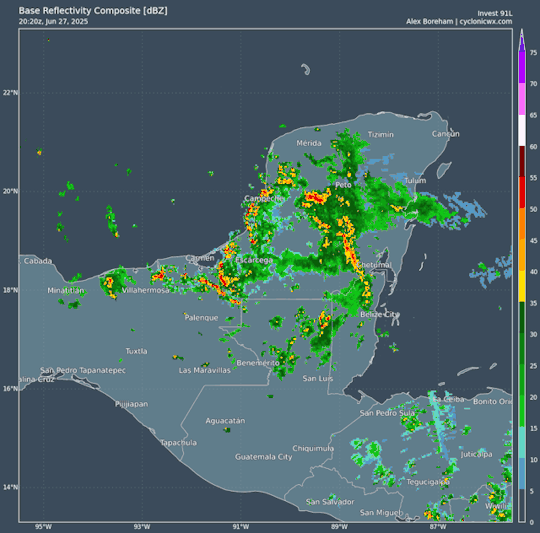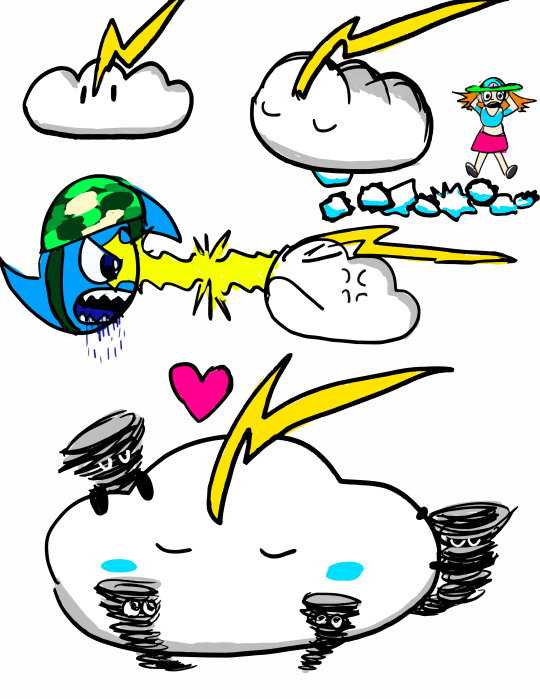#cyclonic circulation
Explore tagged Tumblr posts
Text
Jharkhand Braces for Intense Monsoon Activity
IMD Predicts Widespread Rainfall Across State Jharkhand anticipates significant monsoon activity, with IMD forecasting widespread rainfall. Early monsoon arrival brings hope amidst 52% seasonal deficit, as state prepares for potential heavy downpours. RANCHI – Jharkhand is set to experience significant monsoon activity over the next 48 hours, according to the latest bulletin from the India…

View On WordPress
#agricultural impact#राज्य#cyclonic circulation#early monsoon onset#IMD rainfall alert#Jharkhand monsoon forecast#Monsoon Trough#northeastern Jharkhand weather#rainfall deficit#Simdega heavy rainfall#state#weather systems
2 notes
·
View notes
Text
Ride The Cyclone Ask Game!!!
Just some fun little questions!! Please do rant as much as you want with any and all of your answers :D
Favourite production?
Favourite character?
Least favourite character?
Favourite song?
Least favourite song?
How would you rank the opening songs?
Favourite cut song?
Favourite cut character?
Unpopular opinion? Or if you don't have any, a popular opinion you agree with?
Favourite ship?
Least favourite ship/ship that you don't understand the hype for?
Favourite RTC actor(s)?
Favourite representation of [insert ship]?
Favourite interpretation of [insert character]?
Favourite take on [insert song]?
Favourite costumes/set design?
Favourite vocal performance?
What are your headcanons for [insert character]?
Do you have any theories?
Favourite RTC fanfic/fic author/fic recs in general?
Favourite RTC fanart/fanartist/any fanart you love?
Do you have any OCs? If so what are they like?
What would your catchphrase be and/or what 'The ___ in Town' would you be called?
Favourite line of dialogue?
Something you haven't seen in a production that you want to?
Any underrated productions you love?
How many productions have you watched? Which ones?
Have you ever been to see a RTC production?
If you were in a production of RTC, who would you play?
Overall favourite part of RTC and/or the fandom?
#did i make this because i want to answer rtc questions yes yes i did#these are pretty simple questions tbh#they have probably all been done before but i haven't seen an ask game in circulation recently#so i hope people use this :D#ride the cyclone#rtc#rtc musical#ask game
201 notes
·
View notes
Text
ফুঁসছে স��গর..! পশ্চিমি ঝঞ্ঝা ঘূর্ণাবর্ত..! কাঁপিয়ে বৃষ্টি দক্ষিণবঙ্গের ৪ জেলায়
আগামী ৪৮ ঘণ্টায় বজ্রবিদ্যুৎ-সহ বৃষ্টির সম্ভাবনা বেশি থাকবে পূর্ব মেদিনীপুর উত্তর ও দক্ষিণ ২৪ পরগনা, হাওড়া, কলকাতা, মুর্শিদাবাদ, নদিয়া, বীরভূম, পূর্ব ও পশ্চিম বর্ধমান জেলায়। Source link
View On WordPress
#৪৮ ঘণ্টায় বজ্রবিদ্যুৎ-সহ বৃষ্টি#Cyclonic Circulation Update#IMD Latest Weather#Rainfall Alert#Thunder storm alert in South Bengal IMD predicts heavy rain and gusty wind forecast in these states#West bengal Weather#আবহাওয়ার আপডেট#কলকাতা#জেলা#নদিয়া#নিম্নচাপ সতর্কতা#পূর্ব ও পশ্চিম#পূর্ব মেদিনীপুর উত্তর ও দক্ষিণ ২৪ পরগনা#বর্ধমান#বাংলার আবহাওয়া#বীরভূম#বৃষ্টি#ভারী বৃষ্টির পূর্বাভাস#মুর্শিদাবাদ#হাওড়া
0 notes
Text
"A team of researchers at Washington University in St. Louis has developed a real-time air monitor that can detect any of the SARS-CoV-2 virus variants that are present in a room in about 5 minutes.
The proof-of-concept device was created by researchers from the McKelvey School of Engineering and the School of Medicine at Washington University...
The results are contained in a July 10 publication in Nature Communications that provides details about how the technology works.
The device holds promise as a breakthrough that - when commercially available - could be used in hospitals and health care facilities, schools, congregate living quarters, and other public places to help detect not only the SARS-CoV-2 virus, but other respiratory virus aerosol such as influenza and respiratory syncytial virus (RSV) as well.
“There is nothing at the moment that tells us how safe a room is,” Cirrito said, in the university’s news release. “If you are in a room with 100 people, you don’t want to find out five days later whether you could be sick or not. The idea with this device is that you can know essentially in real time, or every 5 minutes, if there is a live virus in the air.”
How It Works
The team combined expertise in biosensing with knowhow in designing instruments that measure the toxicity of air. The resulting device is an air sampler that operates based on what’s called “wet cyclone technology.” Air is sucked into the sampler at very high speeds and is then mixed centrifugally with a fluid containing a nanobody that recognizes the spike protein from the SARS-CoV-2 virus. That fluid, which lines the walls of the sampler, creates a surface vortex that traps the virus aerosols. The wet cyclone sampler has a pump that collects the fluid and sends it to the biosensor for detection of the virus using electrochemistry.
The success of the instrument is linked to the extremely high velocity it generates - the monitor has a flow rate of about 1,000 liters per minute - allowing it to sample a much larger volume of air over a 5-minute collection period than what is possible with currently available commercial samplers. It’s also compact - about one foot wide and 10 inches tall - and lights up when a virus is detected, alerting users to increase airflow or circulation in the room.
Testing the Monitor
To test the monitor, the team placed it in the apartments of two Covid-positive patients. The real-time air samples from the bedrooms were then compared with air samples collected from a virus-free control room. The device detected the RNA of the virus in the air samples from the bedrooms but did not detect any in the control air samples.
In laboratory experiments that aerosolized SARS-CoV-2 into a room-sized chamber, the wet cyclone and biosensor were able to detect varying levels of airborne virus concentrations after only a few minutes of sampling, according to the study.
“We are starting with SARS-CoV-2, but there are plans to also measure influenza, RSV, rhinovirus and other top pathogens that routinely infect people,” Cirrito said. “In a hospital setting, the monitor could be used to measure for staph or strep, which cause all kinds of complications for patients. This could really have a major impact on people’s health.”
The Washington University team is now working to commercialize the air quality monitor."
-via Forbes, July 11, 2023
-
Holy shit. I know it's still early in the technology and more testing will inevitably be needed but holy shit.
Literally, if it bears out, this could revolutionize medicine. And maybe let immunocompromised people fucking go places again
Also, for those who don't know, Nature Communications is a very prestigious scientific journal that focuses on Pretty Big Deal research. Their review process is incredibly rigorous. This is an absolutely HUGE credibility boost to this research and prototype
#covid#covid 19#pandemic#plague#rsv#influenza#the flu#science and technology#medical research#medical technology#biochemistry#immunology#good news#hope#hope posting
6K notes
·
View notes
Note
words to use instead of air/wind?
Air—the mixture of invisible odorless tasteless gases (such as nitrogen and oxygen) that surrounds the earth
Wind—a natural movement of air of any velocity
Airflow - a flow of air; especially: the motion of air (as around parts of an airplane in flight) relative to the surface of a body immersed in it
Airstream - a current of air
Billow - to bulge or swell out (as through action of the wind)
Blast - a violent gust of wind
Blow - an instance of air moving with speed or force; a blowing of wind especially when strong or violent
Bluster - a violent boisterous blowing
Breath - a slight breeze; air inhaled and exhaled in breathing
Breeze - a light gentle wind
Buran - a northeasterly wind of gale force in Russia and central Asia usually identified with sandstorms in summer and blizzards in winter
Chinook - a warm moist southwest wind of the coast from Oregon northward; a warm dry wind that descends the eastern slopes of the Rocky Mountains
Current - the part of a fluid body (such as air or water) moving continuously in a certain direction
Cyclone - a storm or system of winds that rotates about a center of low atmospheric pressure, advances at a speed of 20 to 30 miles (about 30 to 50 kilometers) an hour, and often brings heavy rain
Draft - a current of air in a closed-in space
Eddy - a current of water or air running contrary to the main current; especially: a circular current
Flatus - gas generated in the stomach or bowels
Flurry - a gust of wind
Gale - a strong current of air
Gas - a fluid (such as air) that has neither independent shape nor volume but tends to expand indefinitely
Gust - a sudden brief rush of wind
Headwind - a wind having the opposite general direction to a course of movement (as of an aircraft)
Mistral - a strong cold dry northerly wind of southern France
Northeaster - a strong northeast wind
Norther - a strong north wind
Northwester - a strong northwest wind
Puff - an act or instance of puffing; whiff
Respiration - the movement of air or dissolved gases into and out of the lungs
Scud - a gust of wind
Sigh - the sound of gently moving or escaping air
Slipstream - a stream of fluid (such as air or water) driven aft by a propeller
Southeaster - a strong southeast wind
Southwester - a strong southwest wind
Squall - a sudden violent wind often with rain or snow
Storm - wind having a speed of 64 to 72 miles (103 to 117 kilometers) per hour
Stream - any body of flowing fluid (such as water or gas)
Tailwind - a wind having the same general direction as a course of movement (as of an aircraft)
Tempest - a violent storm; a disturbance of the atmosphere accompanied by wind and often by precipitation (as rain or snow)
Tornado - a violent destructive whirling wind accompanied by a funnel-shaped cloud that progresses in a narrow path over the land
Updraft - an upward movement of gas (such as air)
Uprush - an upward rush (as of gas or liquid)
Vapor - a substance in the gaseous state as distinguished from the liquid or solid state
Ventilation - circulation of air
Waft - a slight breeze; puff
Westerly - a wind from the west
Whiff - a quick puff or slight gust especially of air, odor, gas, smoke, or spray
Whirlwind - a small rotating windstorm of limited extent
Williwaw - a sudden violent wind
Windblast - a gust of wind
Windflaw - a gust of wind
Windstorm - a storm marked by high wind with little or no precipitation
Zephyr - a breeze from the west
Hope this helps with your writing. Do tag me, or send me a link. I'd love to read your work!
More: Word Lists
#anonymous#word list#nature#writeblr#spilled ink#dark academia#langblr#linguistics#words#creative writing#writing prompt#light academia#literature#poetry#writers on tumblr#writing reference#wind#air#writing resources
111 notes
·
View notes
Text

91L is maybe already a tropical cyclone. NHC will probably wait 'til 9z at the earliest but radar doesn't lie - that's a cyclonic circulation.
2 notes
·
View notes
Text
Name That Ghoulette
Definitions + Justifications under the cut
Cyclone: A tropical storm; a system of winds rotating inward to an area of low atmospheric pressure, with a counterclockwise (northern hemisphere) or clockwise (southern hemisphere) circulation; a depression. Cyclone: "1.Natural Disaster based Ghoul(ette) names go hard as hell 2. it fits the air element"
Nebula: a cloud of gas and dust in outer space, visible in the night sky either as an indistinct bright patch or as a dark silhouette against other luminous matter. Nebula: "space themed"
3 notes
·
View notes
Note
Greetings Tammie;
I’m DJ Legacy, I’m trying to figure out more information about the current Big Run situation.
Are you a member of a tribe that’s active in the Big Run battles?
[ @dj-legacy ]
This seems important. I’m glad to answer.
My tribe does participate. A lot of us work some machinery and the ones that don’t? They pick up their pans and help too. While we aren’t as big of a presence as some, we definitely always send some out. I personally have participated awhile back and even when I’m more active on the battle field I spend time on the side helping to repair stuff for others. This will be my first one in a bit.
Cyclone messaged me about the miscommunication. It’s very dangerous for something like that to circulate. We are going to inkblot.
I’m… very worried. I can feel everything shifting. When is it going to erupt?
Going to try not to ramble too much. I’m not myself these days.
#splatoon rp#splatoon oc#splatoon roleplay#splatoon oc rp#lifeofasalmon#splatoon 3#splatoon#splatoon roleplay blog
7 notes
·
View notes
Text





Cloud atlas of mars showcases array of atmospheric phenomena
Cloud enthusiasts have a new tool to investigate striking formations in the skies above the Red Planet. A browsable database of 20-years-worth of images of clouds and storms, created by the German Aerospace Centre (DLR) in Berlin, is helping scientists better understand how and where features arise in the martian atmosphere and what they can tell us about the climate of Mars and other planets. The Mars ‘Cloud Atlas’, which is available to the public at https://hrscteam.dlr.de/public/data.php, has been presented this week at the Europlanet Science Congress (EPSC) 2024 in Berlin by Daniela Tirsch of DLR.
The images in the Cloud Atlas have been captured by the High Resolution Stereo Camera (HRSC) instrument, which has been in orbit on board the European Space Agency (ESA) Mars Express spacecraft since 2005. Although Mars has a very thin atmosphere, numerous cloud formations and dust storm phenomena can develop from water and carbon dioxide ice crystals as well as dust particles.
“Clouds on Mars are just as diverse and fascinating as those we see in our skies on Earth, with some features unique to the Red Planet. One of my favourite phenomena are the beautiful ‘cloud streets’ – linear rows of fleecy clouds that develop around the huge volcanic Tharsis rise and the northern lowlands in northern spring and summer. While they resemble cumulus clouds on Earth, they are formed under different atmospheric conditions,” said Dr Tirsch. “We also see impressive dust clouds that can spread hundreds of kilometres – a phenomena we luckily don’t experience on Earth.”
Dust plays a major role in the atmosphere and climate of Mars. Rare upwelling events can leave beige, dust-laden blobs hanging in the atmosphere. Large differences in temperature and air pressure at certain seasons can result in stronger-than-usual winds that lift large amounts of dust from the Martian surface. Dust clouds spreading from the tops of giant volcanoes take on the appearance of eruption clouds, although they are no longer active.
Large spiral dust storms and cyclone systems can also be observed each year near the Martian north pole. Studying these phenomena is crucial to scientists in understanding the atmosphere and air mass circulation on Mars.
Rippling ‘gravity clouds’ are one of the most common formations on both Mars and the Earth. They are seen at mid-latitudes in winter for both hemispheres, as well as over the Tharsis volcanic plateau in southern winter. Lee waves, a special type of gravity clouds, can build up on the downwind side of ridges, mountains and other obstacles to create repeating ridge formations.
Some types of clouds studied are specific to locations and seasons; others like ‘twilight clouds’ can appear in the early morning at any place or time of year.
The HRSC Cloud Atlas will provide valuable insights into the physical nature and appearance of clouds and storms, the time of their occurrence and their location. This knowledge will help better understand the atmospheric dynamics and the climate cycles on Mars, as well as providing input for studies of the climate on other planets such as Earth and Venus. The DLR team has already used the database to create global maps showing the occurrence of various types of cloud as a function of season and location.
“As Mars Express has been extended by ESA until at least 2026, this will enable us keep filling this database and refine even further our understand of Mars atmosphere,” said Dr Tirsch.
TOP IMAGE: An example of cloud streets over Vastitas Borealis, a large area near the North Pole mostly devoid of craters. Credit ESA/DLR/FU Berlin/A. Cowart
CENTRE IMAGE: Lee waves are a special type of cloud created by the wind encountering obstacles and build up on the ‘leeward‘ or downwind side. The geometries of the lee waves depend on the shape of the obstacles. Credit ESA/DLR/FU Berlin.
LOWER IMAGE: This elongated cloud has formed as a result of wind encountering the Arsia Mons mountains. It forms almost every day during a specific season, from early morning until noon. Credit Credit: ESA/DLR/FU Berlin/A. Cowart.
BOTTOM IMAGE: Lee waves are a special type of cloud created by the wind encountering obstacles and build up on the ‘leeward‘ or downwind side. The geometries of the lee waves depend on the shape of the obstacles. Credit ESA/DLR/FU Berlin.
FINAL IMAGE: This image displays two atmospheric phenomena: the white curved lines are gravity wave clouds, while the brown areas are dust lifted from the ground by wind. The colour shift visible in the dust lifting event might be indicative of very fast winds, a phenomenon currently under investigation by other members of the team. Credit ESA/DLR/FU Berlin.
4 notes
·
View notes
Text


MELISSA AND THE ALLIES OF GAIA ART DUMP 1 - THE SUPERCELL
In episode 9 of the story "Melissa and the Allies of Gaia" I posted on Wattpad in August, Melissa and her storm avatar partner Hurricane Carla (shown in her miniature form) face off against a sapient high-precipitation supercell over a salt marsh in Alabama. A pair of fisherman have been using the tornadoes/waterspouts it creates to catch fish, having used an artifact of evil weather magic to take control of the storm.
Since actually moving to Alabama (I had no idea I would end up there at the time I wrote the story chapter) I have kind of developed a new fondness for this character. Most of the characters in the story I have done art previously for but I have never drawn this one.
While I don't specify this in the story, I imagine this supercell to use she/they pronouns (insert mammatus cloud joke here) and the tornados are like her "children" that she lets out to "play" (I mean if you scaled up a toddler to the size and strength of a tornado you'd probably get as much destruction). I plan for her to come back in a sequel, though of course Melissa will end up calling her something like "Mr. Thunders." (not that I imagine she would care all that much, of course, being a giant storm and all).
Like the hurricane avatars, she has a miniature form (shown in the top image) that she stays in when conditions aren't right for her to build up her massive supercell body. It looks like a cute little cumulus cloud with a thunderbolt crest. She doesn't speak any human language, and in the story she only briefly speaks in the wind language of storms to Carla, so she isn't very talkative. For this reason I imagine Melissa might one day try to keep her as a pet, which of course goes terribly wrong (as you can see in the first page with "Mr. Thunders" pooping huge spiky hail all over her apartment ["Mr Thunders! Not on the car!"]).
Shown in the top image is also her standing off against the miniature form of Labor Day and glaring at him with lightning. This happens in the story because Labor Day gets really hungry after the wind shear causes dry air to be entrained in his circulation and he basically loses control for a brief moment and tries to eat her waterspouts. Needless to say "Mr. Thunders" doesn't like this one bet, and attacks Labor Day. Fortunately it turns out "Mr. Thunders" also is hungry for some warm moist air too and they end up just kind of returning to Gulf Coast Headquarters and having lunch on some tropical air from the Gulf of Mexico.
The final drawing on the first image shows them snuggling with their tornado children. Ultimately I imagine she only wants what is best for them. It just so happens that sometimes what is best for a tornado isn't what is best for humans.
Some more notes on her design:
-Since she's a high precipitation supercell I imagine she has a lot of precipitation falling both from her anvil and from her base, which obscures anything like the wall cloud etc. This also conveniently means I don't have to draw all the features in the base of the supercell because I can't make heads or tails of how they are arranged lol (you can tell I have more experience with tropical cyclones)
-I basically imagined her thunderhead anvil is like her hat. It actually extends far ahead of and behind her head (it is extended by the upper level wind shear) but since she's viewed from the front it is foreshortened. From the side it would be quite long.
-Her eye color is supposed to be the deep green seen in storms with a lot of hail as the sun sets. I imagine her triangular pupil actually looks like a conical tornado up close.
-I had previously in the webcomic drawn Melissa as having a peace sign beanie or skullcap, but I realized when writing the story that that sort of hat doesn't make sense for her home of Galveston, which has a hot climate. I imagine it's more of a sunhat now. (Okay this isn't about the supercell's design but I think it's important)
#character designs#meteorology#supercell#storm#cloud#thunderstorm#tornado#waterspout#hurricane#tropical cyclone#weather#sky
4 notes
·
View notes
Text
2024 Hurricane Season Breaks an Unusual Record, Thanks to Hot Water

The 2024 hurricane season has already made history, setting an unprecedented record that highlights the stark contrast between Atlantic and Pacific storm activity. For the first time since satellite monitoring began in 1966, the Atlantic basin has generated more accumulated cyclone energy (ACE) than the entire Pacific Ocean through early July. This unusual phenomenon is largely attributed to the exceptionally warm water temperatures across much of the North Atlantic. Phil Klotzbach, a senior research scientist at Colorado State University, explains that these abnormally high ocean temperatures are influencing storm activity in both oceans, albeit in opposite ways. In the Atlantic, the warm waters have fueled an active start to the hurricane season. The region has already experienced several named storms, including the powerful Hurricane Beryl in early July. This early season activity has contributed to the record-breaking ACE levels, which measure the total energy of a hurricane season based on storm frequency and maximum wind speeds.

Conversely, the Pacific has seen an unusually quiet start to its tropical cyclone season. The western North Pacific experienced only one typhoon in May, and for only the second time on record since 1950, it went without a named storm from June 1 to July 15. In the eastern North Pacific, Tropical Storm Aletta's formation on July 4 marked the latest start to the season on record in that region. Scientists attribute this lack of Pacific storm activity to several factors, including the absence of a strong monsoon trough in the western North Pacific and excessive easterly wind shear in the eastern North Pacific. Interestingly, the warm Atlantic waters are contributing to these conditions by influencing global wind patterns. The dramatic spike in tropical Atlantic water temperatures from March to June 2024 has persisted, creating a La Niña-like circulation pattern. This pattern reduces westerly wind shear in the Atlantic, making conditions more favorable for storm formation. However, it increases easterly winds in the eastern North Pacific, hindering tropical storm development in that region. While it's still early in the hurricane season, forecasters predict above-normal activity for the Atlantic basin. The National Oceanic and Atmospheric Administration (NOAA) forecasts 17 to 25 named storms, including 8 to 13 hurricanes, of which 4 to 7 could become major hurricanes.
As the season progresses, researchers will continue to study the influence of climate change and other factors on tropical cyclone patterns. The unusual start to the 2024 season serves as a reminder of the complex interplay between oceanic and atmospheric conditions in shaping hurricane activity across different regions.
Are you ready to maximise your chances of recovering damages? Contact us now, call 8338582031 to get a FREE CONSULTATION with both a state appraiser and an attorney! When you contact us, you will receive immediate consultation from both a state appraiser and an attorney. Get a preliminary assessment of the damage to your property and an estimate of potential insurance compensation. Take advantage of the expertise of construction professionals to accurately assess property damage.
#HurricaneSeason2024#AtlanticHurricanes#ClimateChange#WarmOceans#TropicalCyclones#WeatherPatterns#StormActivity#PacificHurricanes#AccumulatedCycloneEnergy#ACERecord#OceanTemperatures#AtlanticBasin#PacificBasin#NOAA#HurricaneForecast#ExtremeWeather#ClimateScience#MeteorologicalRecords#GlobalWindPatterns#SeaSurfaceTemperatures#disaster#disaster twins#beautiful disaster#iowa state cyclones#disaster lineage#natural disasters#the disaster of psi kusuo saiki#the disasterous life of saiki k#the owl house#tornado
6 notes
·
View notes
Text
Heavy Rain Alert Issued for Jharkhand Over Next 48 Hours
IMD predicts thunderstorms and lightning in isolated areas amid ongoing rainfall deficit Jharkhand braces for heavy rainfall in isolated areas as IMD issues an alert, despite the state’s current 43% rain deficit. RANCHI – The India Meteorological Department (IMD) has issued a heavy rain alert for isolated areas in Jharkhand over the next 48 hours, as well as lightning and thunderstorm…
#राज्य#cyclonic circulation#IMD weather forecast#India Meteorological Department#isolated heavy rainfall#Jharkhand districts rainfall deficiency#Jharkhand heavy rain alert#Monsoon Trough#rainfall deficit in Jharkhand#state#thunderstorm warning#weather preparedness
1 note
·
View note
Text
4. The Digital Theatre Experience: Watching Bootlegs
Clearly, fans are not flocking to bootlegs for the quality. As outlined in this post, the actors' faces are often blurred from the bright lights, the sound quality is poor, and inevitably a nearby audience member will make distracting noise, brought up here as well. No digital approximation can truly replicate the immersive experience of attending a show live. Why, then, are bootlegs so popular?
As previously discussed, this is in part due to accessibility (or lack thereof). Bootleg recordings are the easiest and cheapest way to experience a show and it is not difficult to find them, especially if one is already in a thriving fan community such as Tumblr's. Fans are grateful for the bootleg's influence on fan-made media (discussed further in this post), and can often find great comfort in returning to beloved shows on demand.
The bootleg trading community is alive and well on Tumblr, seen in posts like this (not exclusive to musical theatre), as well as respondents to this poll, who indicated that they personally archive their own bootleg libraries:


The other side of bootleg trading can also be seen here where a user asks if any fellow fans have access to a recording of Ride the Cyclone featuring a well-known actor (Taylor Louderman) who had only briefly been in the cast, making this bootleg rare. Rare bootlegs are coveted by collectors and fandom archivists, but the general fan population tend to gravitate toward the most popular bootlegs, often those which feature the most well-known cast (usually those who were on the cast album). Examples of these types of cast are "OBC" (Original Broadway Cast), "OOBC" (Original Off-Broadway Cast), and "West End," and it is these shows which circulate YouTube.
An anonymous Tumblr user sent this ask inquiring how most fans tend to save their bootlegs. According to the results of the poll cited above, YouTube is the most popular platform for bootleg consumption. However, it is also the least reliable, as these videos are prone to being removed under copyright law. Some users take to downloading these videos to a personal drive before they can be removed, though many casual viewers will simply wait until the "Slime Tutorial" is inevitably reuploaded under a slightly different title.
Bootleg videos contribute to fan culture in plenty of other ways, too. Most fan-made paratextual media is derived from bootlegs, especially in the form of GIFs and short videos/edits. These short forms draw more careful attention to the moments that they show, and are therefore helpful tools for fan analysis.
The Tumblr "gifset" is a post which often incorporates highly edited .GIF files which have been artfully arranged, though may sometimes feature one or two raw GIFs. These posts tend to highlight aspects such as a particular character dynamic, casting choices, or a favourite moment.
Similarly, short clips are excellent tools for archiving moments unique to a particular performance, such as this ad-lib in Beetlejuice, or this time that a line was altered in Heathers for one show, briefly canonizing the main character as bisexual (she is otherwise a straight woman, though her potential bisexuality is a popular fan theory). If no fan had been recording those performances, these fleeting moments of theatre could not have been immortalized. Therefore, it can be argued that despite their illegality, bootleg videos serve not only to record the production's entirety, but also to preserve the minutia of the actors' craft.
The sheer power of the internet has inadvertently spawned a new form of theatre patronage: the bootleg archivist. Although they contribute no money aside from the tickets that they bought to film, their contribution to the development of fan culture in the digital age is undeniable. Many fans cite bootlegs as their introduction to their most beloved shows, while others collect for the sake of cultural preservation. Regardless, this digital theatre community is one which has brought significant amounts of attention to the shows' names.
Why, then, is the musical fan community so looked down upon by theatre critics and executives? Is it fair to discredit fan-favourites, even if they become box office hits? What happens when fans influence a show's perception?
<<<First <<Prev Next>>
3 notes
·
View notes
Note
Jupiter’s Great Red Spot, which rotates once approximately every six days, is an anti-cyclonic storm 22° south of the planet’s equator.
:3
!!! Neat!!! I had to look up what anti-cyclonic meant: so for those who don't know it's a storm system that is surrounding a high atmospheric pressure system, as opposed to a regular cyclone which goes around low pressure. This also makes the winds circulate in the opposite direction!!
I also learned, as a by product, that cyclones go in the same direction all the time, but that the direction is dependent on hemisphere?! goodbye backwards Australian toilets and hello backwards Australian cyclones!
thank you anon for the fun fact and for the learning journey!!!
2 notes
·
View notes
Text
Heavy rain with lightning in Odisha for next 6 days: IMD
IMD predicts heavy rain and thunderstorms in Odisha due to cyclonic circulation, issuing a Yellow Warning for several districts till July 17. Heavy rain and thunderstorm with lightning and gusty surface wind speed reaching 30-40 kmph is very likely to occur at one or two places over the districts of Nuapada, Sundargarh, and Mayurbhanj on Friday.
0 notes
Text
Ninja | Indoor Grill | Foodi | 5-in-1 (Grill, Air Fry, Roast, Bake, and Dehydrate | Fits up to 3lb Roast | Smoke Control System and Dishwasher Safe Parts| Black/Grey | AG301
Price: (as of – Details) Meet the Ninja Foodi Indoor Grill. The grill that sears, sizzles, and air fry crisps. With unique Cyclonic Grilling Technology, 500F rapid cyclonic air circulates around food for amazing Surround Searing, while the 500F high-density grill grate gives you delicious char-grilled marks and flavor virtually smoke-free. It’s also an air fry crisper, allowing you to enjoy…

View On WordPress
#3lb#5in1#AG301#Air#air fryer#air purifier#Bake#BlackGrey#charging stand#comfort slippers#control#countertop blender#Dehydrate#designer handbag#dishwasher#Fits#Foodi#Fry#Grill#Indoor#LED lights#modeling clay#Moisturizer#Ninja#Ninja Air Fryer#parts#portable charger#portable SSD#puzzle cube#Roast
0 notes